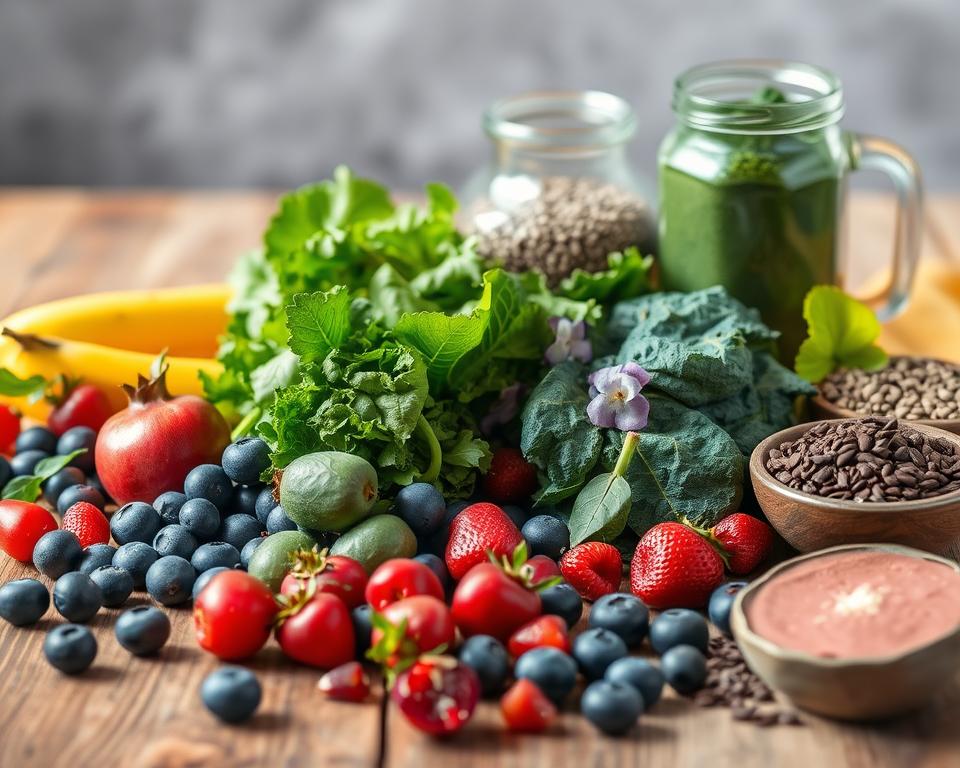Anúncios
Curious how your grocery cart and daily bites will change this year? You’ll scan the biggest shifts shaping food and health, from label changes to what brands put on shelves.
GLP-1 use, new public health advisories, and rising recall rates are nudging how products are marketed and what you see at stores like Whole Foods.
You’ll learn practical ways to balance protein, beans, and plants without losing flavor.
Expect a beverage playbook for moderating alcohol and picks for low-sugar options, plus tips to spot dubious “natural” weight-loss claims.
By the end of this piece, you’ll get evidence-informed guidance, easy recipes, and label-savvy advice to use at the store and in your kitchen. Check with a qualified pro for personalized help.
Anúncios
Introduction: nutrition trends 2025 shaping how you eat right now
nutrition trends 2025 are guiding simple, practical food decisions you can use today.
This matters in the U.S. because several signals are shifting what you buy and how you plan meals. Class I food recalls rose sharply in 2024, a Surgeon General advisory has refocused views on alcohol, and no/low-alcohol options are expanding. At the same time, expected updates to dietary guidelines are nudging more plant-forward protein choices like beans, peas, and lentils.
What you’ll learn: this report translates research and market signals into clear actions for meals, snacks, and beverages. You’ll get sections on drivers, protein variety, fermented foods, beverage swaps, sustainability, GLP-1 influence, and smarter snacking.
Anúncios
Use this as a practical toolkit, not a prescription. Track how changes affect your energy, sleep, and digestion, and check labels, ingredients, and serving sizes—especially for functional drinks and packaged foods. For personalized advice, consult a clinician or registered dietitian before making major changes.
nutrition trends 2025 at a glance: what’s driving change
What shapes the shelf today is a mix of policy signals, safety alerts, and shifting buyer habits. You’ll notice these drivers in labels, in ads, and on store endcaps.
Health signals: dietary guidelines, gut focus, and aging
Dietary guidelines are moving toward more plant-forward protein like beans, peas, and lentils. That nudges product makers to highlight legumes and canned pantry staples.
Interest in gut health keeps fermented foods in the spotlight. Yogurt, kefir, kimchi, and miso show up across dairy cases and deli shelves.
Healthy aging and weight management appear in marketing and in product claims. If you try a product for those reasons, compare fiber, sugar, and sodium—not just the claim.
Market signals: recalls, retailer forecasts, and beverage shifts
Class I FDA recalls rose sharply last year. That higher recall rate makes you read labels and prefer brands with clear sourcing and safety notes.
FSIS actions on listeria may change storage labels and testing on ready-to-eat items. Expect more no-/low-alcohol and tea-based food beverage options in the aisle as alcohol risk communication grows.
- Look for high-protein tags and “GLP-1 friendly” claims but treat them as marketing.
- Compare ingredients and serving sizes before assuming health benefits.
Protein stays popular, but quality and variety win
Simple changes to what you place on your plate make a big difference for satiety and long-term health.
High-protein without the hype
Prioritize variety: Greek yogurt, cottage cheese, beans, lentils, and nuts all deliver protein and different nutrients.
An advisory committee suggested aiming for at least 2.5 cups of beans and lentils per week, and to consider legumes, seeds, and soy ahead of relying on meat and eggs.
Real-life swaps for balanced plates
Try a bean-and-veggie chili instead of a beef-only pot. Use yogurt dips in place of sour cream. Top bowls with a handful of nuts for crunch and healthy fats.
Most people do well with a palm-size protein portion per meal; increase that if your activity and appetite require it.
Personalize without crowding out plants
Keep plants and whole grains present. Pair proteins with vegetables, whole grains, and healthy fats for fiber and micronutrients.
“Use plant-forward proteins to support satiety and sustainability while keeping taste and texture.”
If you have specific needs or are managing weight or medical conditions, check in with a registered dietitian for tailored guidance.
- Budget tip: canned beans and tuna are convenient; rinse canned beans to cut sodium.
- Watch added sugar in flavored dairy and sodium in cottage cheese and jerky-style foods.
- Use meat as a flavor accent and let beans and vegetables take center stage.
Gut health goes mainstream with fermented favorites
Everyday meals are getting a tangy upgrade as fermented options gain wider popularity for flavor and modest health perks.
Everyday options to try
Yogurt and kefir offer a quick breakfast or smoothie base. Kimchi, sauerkraut, miso, and tempeh fit grain bowls, tacos, and stir-fries.
The AMA notes a healthy gut supports digestion, metabolism, and immunity, so include fermented foods as part of whole meals rather than relying on any single item.
Simple habits you can add
Add a spoonful of sauerkraut to sandwiches or kimchi to grain bowls for tang and crunch. Stir miso into broths off the heat and use tempeh in salads for plant-based protein.
Keep cold-chain items refrigerated and check labels for “live and active cultures.” If you are sodium-sensitive, compare brands of pickled vegetables.
Sourdough’s resurgence: what we know
“Sourdough fermentation can create prebiotics and may be easier to digest for some, but effects vary by person.”
Sourdough has regained attention, and whole-grain versions offer more fiber and micronutrients. Still, health benefits are mixed and not guaranteed for everyone.
- Start with one familiar fermented item, like yogurt or kefir, and build from there.
- Rotate different fermented choices across the week instead of relying on a single source.
- If you have a medical condition, talk with your clinician or dietitian before major changes.
From mocktails to functional sips: the new beverage playbook
Your evening drink choices are shifting from heavy pours to lighter, more intentional sips.
The Surgeon General’s advisory highlights cancer risks tied to alcohol and points to clearer labels ahead. No- and low-alcohol options are growing, and Whole Foods expects tea formats to expand in creative ways.
Alcohol moderation momentum and the rise of no- and low-alcohol drinks
If you want to cut back, try no-alcohol beer or botanical spritzers for weeknights.
These products often mirror adult flavors without the same risks, but check serving sizes and label claims before you assume benefits.
Smart swaps: sparkling teas, botanicals, electrolytes, and low-sugar options
Sparkling tea, brewed iced tea with citrus, or seltzer with mint give flavor without added sugar.
Electrolyte mixes can help after hard workouts; pick low-sugar versions and mind sodium content.
Use with care: adaptogens, kava, magnesium, and label literacy
Functional brands like Recess and De Soi offer botanical-based nonalcoholic options, but read ingredient lists closely.
Adaptogens and kava can interact with medicines and affect your liver or sleep. Magnesium drinks vary in dose; track total daily intake.
“Functional beverages can complement, not replace, basics like water or fortified plant milks.”
- Brew your own iced tea, add citrus and mint, and top with unsweetened seltzer to save money.
- Compare labels for added sugars, caffeine, and total electrolytes before buying.
- Monitor how drinks affect your sleep, focus, and mood, and adjust choices accordingly.
Sustainability on your plate: whole foods, plant-forward proteins, better packaging
A few practical swaps — from beans to seaweed — let you eat more sustainably while saving money. Start with whole foods and simple, plant-forward meals that fit your budget and taste.

Low-impact picks that work for your wallet
Choose beans, local leafy vegetables, mushrooms, and small amounts of meat for flavor. These low-impact choices often cost less and keep meals filling.
What to expect from alternative proteins
Industry forecasts show plant-based leads (about 60%) while algae gains share (around 20%). Try soy, pulses, or algae-based seasonings as easy ways to vary your proteins.
Packaging you can act on
Look for biodegradable or recyclable wrapping when quality and price allow. Buy loose produce or bulk dry beans to cut waste and save money.
- Practical steps: Build bowls with beans, greens, and mushrooms several times weekly.
- Rotate seaweed snacks and check iodine content.
- Support brands with clear sourcing and third-party labels when feasible.
“Small shifts add up; prioritize the changes that fit your household and tastes.”
A plant-forward diet pattern can also support healthy aging by adding fiber and micronutrients without sacrificing flavor.
GLP-1 influence, weight management, and responsible choices
When appetite changes, practical grocery choices help you keep energy and nutrients steady through the day.
How GLP-1 use shapes eating patterns and product labels
GLP-1 medications, originally for type 2 diabetes, are now used by many for weight management.
You may notice smaller portions, less craving for sweets, and new “GLP-1 friendly” labels on products. Compare fiber, protein, sugar, and sodium rather than relying on marketing claims.
- Plan higher-protein, higher-fiber meals: beans, lentils, yogurt, and vegetables.
- If appetite is low, choose nutrient-dense mini-meals like Greek yogurt with fruit or lentil soup.
- Keep hydration, regular protein, and fiber across meals to support satisfaction.
Why “natural alternatives” and OTC weight-loss supplements raise red flags
FDA and professional groups warn against non-prescription alternatives that claim GLP-1-like effects. Quality, dosing, and safety can be unclear.
- Talk with your clinician or a registered dietitian before trying supplements or compounded products.
- Track energy, digestion, and mood instead of chasing a number on the scale.
- Focus on simple routines: planned groceries, easy prep, and freezer-friendly portions to support long-term management.
“Discuss any supplement or compounded product with your healthcare team, especially if you take other medications.”
Snacking in 2025: texture, flavor, and function without the extremes
Everyday snack choices now balance texture and function—people want flavor plus staying power. Surveys show 47% eat fruit daily, 38% eat vegetables, and 18% eat nuts or seeds every day (35% weekly). Taste ranks highest (67%), followed by price and ease.
What people actually eat
Common picks include fruit, yogurt cups, nuts, and whole-grain bars. Snack bars grew in unit sales; chewy and crispy textures lead. Choose simple ingredient lists for better food value and convenience.
Better-for-you indulgence
Pair a high-protein treat with fresh produce to extend fullness. Greek yogurt with berries or cottage cheese with pineapple are easy options that help manage weight and curb cravings.
- Stock: fruit, cut vegetables with hummus, yogurt, and nuts or seeds.
- Texture: crunchy nuts, crispy roasted chickpeas, or chewy fruit-and-nut bars keep you satisfied.
- Label checks: compare added sugars, fiber (aim ≥3g), and protein (6–10g for staying power).
- Budget tips: buy bulk nuts, roast canned beans, and try store-brand bars that offer fiber and protein.
“Prep snack boxes for busy days to avoid grazing and make choices you enjoy.”
Conclusion
Your best wins this year will come from easy habits, not dramatic overhauls.
Cook beans weekly, keep yogurt or kefir in the fridge, and build plates around vegetables, whole grains, and reliable protein. Treat beverages as daily choices—lean on tea, seltzer, and low-sugar options while moderating alcohol to fit your goals.
Rotate fermented foods to support gut health, watch labels amid recalls and functional claims, and choose whole foods first. Revisit what worked each month and try one small swap.
If you’re thinking about weight loss or supplements, consult a registered dietitian or your clinician for personalized care. Use reputable resources (Dietary Guidelines, MyPlate, FDA recalls dashboard) to stay informed without overload.

